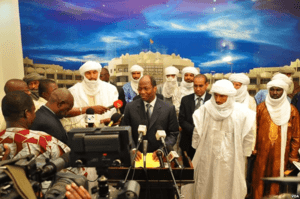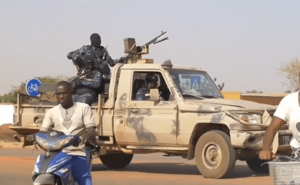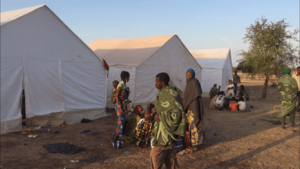Jihadist insurgency in Burkina Faso facts for kids
Quick facts for kids Jihadist insurgency in Burkina Faso |
|||||||||
|---|---|---|---|---|---|---|---|---|---|
| Part of the Islamist insurgency in the Sahel and the spillover of the Mali War | |||||||||
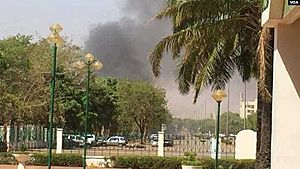 Smoke rising from French Embassy in Ouagadougou, 2 March 2018, during the 2018 Ouagadougou attacks. |
|||||||||
|
|||||||||
| Belligerents | |||||||||
Supported by:
|
|
||||||||
| Commanders and leaders | |||||||||
|
|||||||||
| Casualties and losses | |||||||||
|
2.06 million displaced |
|||||||||
An ongoing war and civil conflict between the Government of Burkina Faso and Islamist rebels began in August 2015 and has led to the displacement of over 2 million people and the deaths of at least 10,000 civilians and combatants.
The war has been interpreted as being the Burkinabè theatre of the insurgency in the Sahel.
Contents
Background
Blaise Compaoré, president of Burkina Faso from 1987 to 2014, treated Islamists somewhat better than French colonial officials did. Compaore's Mauritanian advisor, Moustapha Ould Limam Chafi and General Gilbert Diendéré both contacted several Islamist leaders in order to free hostages held by these groups.
Burkina Faso acted as a mediator during the Mali War between rebels and the government. Burkina Faso led an intervention into the country in 2013. However, in November 2014, Compaoré was overthrown, marking the end of his rule and creating a scenario of instability.
Timeline
On 23 August 2015, the insurgency in the Maghreb spread to Burkina Faso, beginning with a attack on a gendarmerie by alleged Boko Haram members. Between August 2015 and October 2016, seven different posts were attacked across the country, slaying 15 and injuring 11.
On 15 January 2016, terrorists attacked the capital city of Ouagadougou, killing 30 people. Al-Qaeda in the Islamic Maghreb and Al-Mourabitoune both took responsibility.
On 22 March, the leader of Ansarul Islam, Harouna Dicko, was shot dead in Pétéga by security forces.
Between 27 March – 10 April 2017, the governments of Mali, France, and Burkina Faso launched a joint operation named "Operation Panga," composed of 1,300 soldiers from the three countries, in Fhero forest, near the Burkina Faso-Mali border.
The head of Ansarul Islam, Ibrahim Malam Dicko, was killed in June 2017. The group announced a new leader, Jafar Dicko.
In 2018, the insurgency expanded to the east of the country.
In early October, the Armed Forces of Burkina Faso unrolled a major military operation in the country's East, supported by French forces. On 3 December, gendarmes successfully repelled an ambush at Bougui, ten kilometres from Fada N'Gourma.
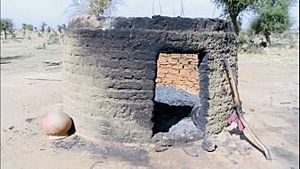
According to Human Rights Watch, between mid-2018 to February 2019, at least 42 people were murdered by jihadists and a minimum of 116 mostly Fulani civilians were killed by military forces without trial. From 31 March to 2 April, ethnic clashes between Fulani, Kurumbas, and Mossis killed 62 people in Arbinda.
On the night of 9–10 May, French forces attacked a jihadist encampment near Gorom-Gorom, freeing four hostages — two French, one South-Korean and one American. Four jihadists and two French soldiers died.
Despite this success, massacres have continued to grow more common.
According to the ACLED, armed violence in Burkina Faso jumped by 174% in 2019, with nearly 1,300 civilians dead and 860,000 displaced.
On 23 January 2022, military officials overthrew Kabore's ruling government. Government failures to quell the Islamist insurgency has been described as a possible motive for the coup, which received unusual popularity. The junta's leader, Paul-Henri Sandaogo Damiba, is well-known for his widely popular military operations against Islamists. Damiba has also replaced government ministers (such as Gilbert Noël Ouédraogo) perceived to have handled the insurgency poorly with more popular figures.
On 18 June, the ECOWAS mediator to Burkina Faso, Mahamadou Issoufou, stated that the Government of Burkina Faso controls 60% the country.
On 22 June 2022, the Government announced the creation of "military zones". Populations in these designated areas will have to leave their homes and lands in order to allow the country's Armed and Security Forces to fight the armed insurgents without any "hindrances".
On 25 June 2022, the Army of Burkina Faso presented a 2-week deadline for populations in the so-called "military zones" to abandon their homes and move to safer zones.
On September 30, 2022, a second military coup within a year occurred, with the military removing Lt Col Paul-Henri Damiba, citing his "inability to deal with an Islamist insurgency". The new leader Col Ibrahim Traoré, who led an anti-jihadist unit in the north of Burkina Faso called Cobra, claimed Damiba was being protected by the French army, which has resulted in violent protests by citizens outside the French embassy. Traoré expects Damiba of plotting a counter-attack, which will push the country into civil war.
On October 2, 2022, religious and community leaders announced that Damiba had agreed to resign from his position after they mediated between him and Traoré. Damiba reportedly demanded seven guarantees in return, including that his allies would be protected, a guarantee for his security and rights, and that the new junta would fulfill the promise he made to the Economic Community of West African States (ECOWAS) about restoring civilian rule in two years.
Humanitarian situation
A humanitarian crisis has erupted in the aftermath of the conflict, with thousands of people killed by both sides. The UNHCR estimates that six in ten displaced people in the Sahel are from Burkina Faso.
See also
 In Spanish: Insurgencia islamista en Burkina Faso para niños
In Spanish: Insurgencia islamista en Burkina Faso para niños
- Jihadist insurgency in Niger


